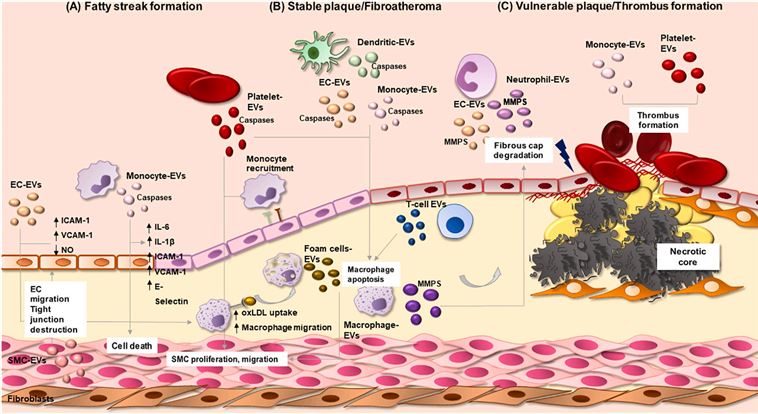Atherosclerotic Plaque Tissue-Vascular Tissue Exosome Communication Research Introduction
Atherosclerosis is a wide range of vascular diseases, and its occurrence and development are closely related to vascular tissue. Studies have shown that injury and inflammation of vascular endothelial cells are early events of atherosclerosis. Damaged vascular endothelial cells can lead to increased permeability of blood vessel walls and aggregation of leukocytes, which can promote the deposition and oxidation of lipid substances in plasma in the blood vessel walls, eventually leading to the formation of atherosclerotic plaques. However, atherosclerotic plaque tissue (APT) can in turn release inflammatory factors and related signals to induce the increased expression of adhesion molecules of vascular endothelial cells and the injury and apoptosis of vascular endothelial cells, thereby accelerating the occurrence and development of endothelial inflammation. Therefore, there is mutual regulation between APT and vascular tissue.
Since exosomes are small vesicles secreted outside cells, they can regulate the biological processes of target cells through a variety of biologically active molecules (such as proteins, lncRNAs, and miRNAs) they carry. Therefore, it is believed that exosomes play a key role in the mutual regulation of the two tissues. Creative Biolabs is a technical service provider that focuses on the research on the mechanism of exosomes in diseases and the discovery of exosome drugs. We can help customers study the regulatory mechanism of exosomes derived from APT in regulating vascular tissue.
Research on Exosome in Atherosclerotic Plaque Tissue-Vascular Tissue Communication
A large number of studies have shown that exosomes derived from APT carry a variety of inflammatory factors, chemokines, and related signals. In addition to aggravating the formation and progression of plaque at the original location, these exosomes can also be circulated into body fluids to expand the scope of atherosclerosis. However, the specific mechanism of influence is unclear. Peng et al. took the lead in using Ldlr knockout rats to establish a carotid atherosclerosis model, and extracted extracellular vesicles (EVs) from APT and blood flowing through the carotid artery. Subsequently, through comparative analysis and q-PCR verification of the miRNA profiles of the two EVs, it was found that EVs derived from APT carried a large number of miR-23a-3p. Through further in vitro mechanism studies, it was found that these EVs could enter the blood and be taken up by vascular endothelial cells. The released miR-23a-3p can be targeted to Dusp5 mRNA to activate the MAPK pathway, thereby promoting endothelial cell inflammation. This finding provides a possible mechanism for exosome-mediated atherosclerotic metastasis.
 Fig.1 EV signalling in vascular inflammation and atherosclerosis.1,2
Fig.1 EV signalling in vascular inflammation and atherosclerosis.1,2
Current treatment methods for atherosclerosis include drug therapy, interventional therapy, and surgical therapy. While these approaches can help slow disease progression and reduce the risk of complications, there are some limitations. Therefore, it is urgent to elucidate the communication mechanism between APT and vascular tissue to find key therapeutic targets for atherosclerosis. Creative Biolabs has always believed that exosomes play a very important role in the progression of diseases and is committed to developing the most comprehensive one-stop platform for tissue exosome research, covering tissue exosome isolation and identification, exosome profiling, exosome proteomics, exosome RNA sequencing, exosome lipidomics and metabolomics, and tissue exosome related services. If you are interested in the communication mechanism between APT and vascular tissue, as well as the communication mechanism between other tissues, please contact us immediately. We would like to work with you to develop the potential of exosomes in disease progression and provide new ideas and methods for early diagnosis and treatment of diseases.
References
-
Charla, E.; et al. Extracellular vesicle signalling in atherosclerosis. Cellular Signalling. 2020, 75:109751.
-
under Open Access license CC BY 4.0, without modification.
For Research Use Only. Cannot be used by patients.
Related Services:

 Fig.1 EV signalling in vascular inflammation and atherosclerosis.1,2
Fig.1 EV signalling in vascular inflammation and atherosclerosis.1,2









